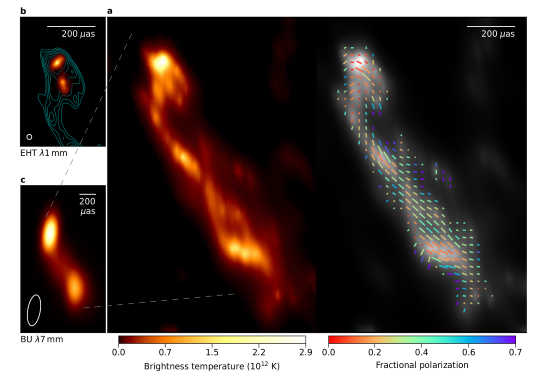
Titol: The filamentary internal structure of the 3C279 blazar jet
Lloc: Seminari del DAA. Edifici Investigació Jeroni Muñoz, planta quarta, a Burjassot.
Dia: dimarts 14 de febrer de 2023. Hora: 12:00.
Resum:
Supermassive black holes at the centre of active galactic nuclei power some of the most luminous objects in the Universe. Typically, VLBI observations of blazars have revealed little information of the ejected plasma internal structure. We show extremely-high angular resolution images of the blazar 3C 279 obtained with the space VLBI mission RadioAstron in 2014, which allowed us to resolve the jet transversely and
reveal several filaments produced by Kelvin–Helmholtz instabilities in a kinetically dominated flow that originate from the core and extend up to 175 parsecs (de-projected) downstream the jet. From the observed linear polarization and strong cross-section emission asymmetry we can infer that the filaments are threaded by a helical magnetic field rotating clockwise in the direction of the flow motion. In the same line, we have now 2018 data of the same source, also with RadioAstron, so we can see whether the source has changed and how, both in shape and polarization.
Teresa Toscano is a junior PhD scientist at the Instituto de Astrofísica de Andalucía (IAA-CSIC), in Granada, in the VLBI group led by José Luis Gómez. She is also a member of the Event Horizon Telescope (EHT), a world-wide Collaboration focused on imaging and studying supermassive black holes M87* and Sgr A*, in which she mainly collaborate on the Imaging and Polarimetry Working Groups, among others. Her research interests are focused on understanding the physical mechanisms of Active Galactic Nuclei taking place in the innermost region of relativistic jets, in order to better understand the launching, collimation and acceleration processes. For this, they need extremely high resolution images and imaging algorithms to recover the structures. One of the programs that provides enough resolution and enables such a study is the VLBI Space Mission RadioAstron, from which I also have data of the very bright and variable blazar 3C279, a very well-known source.






